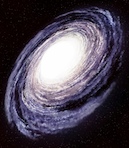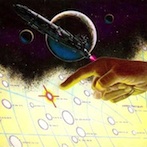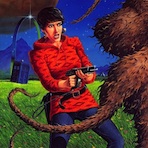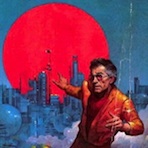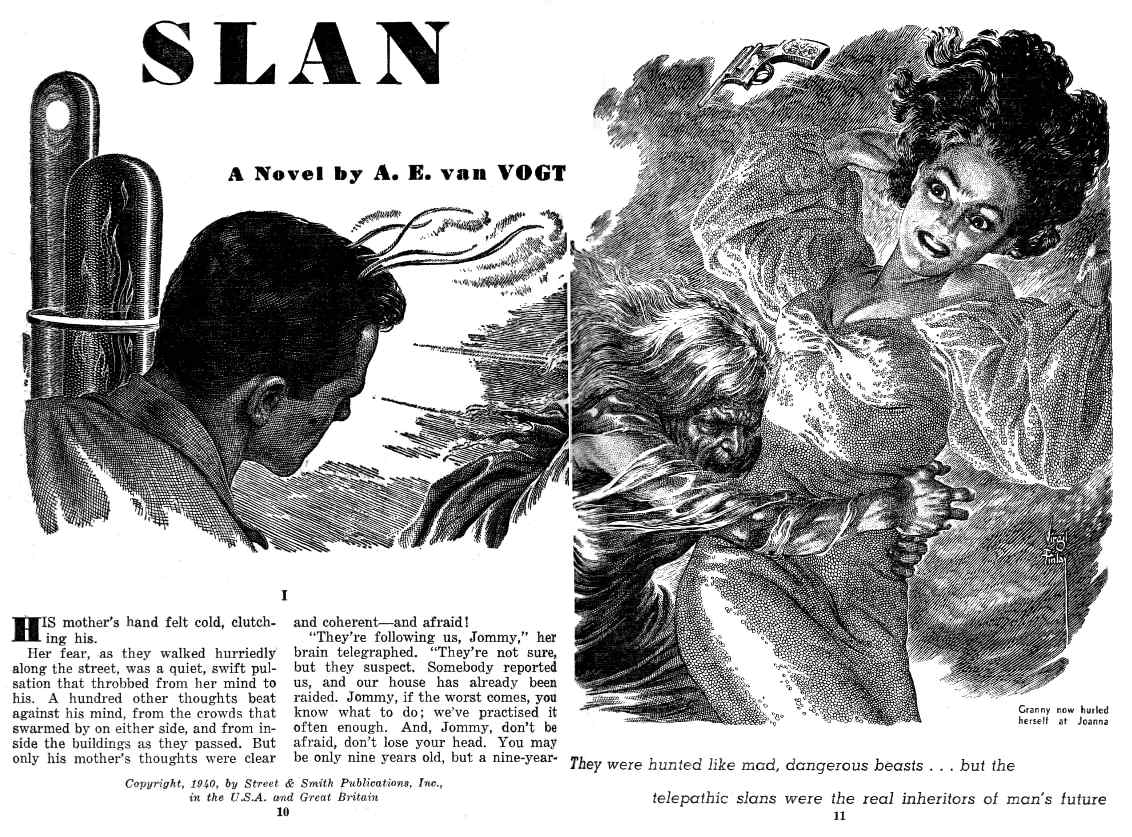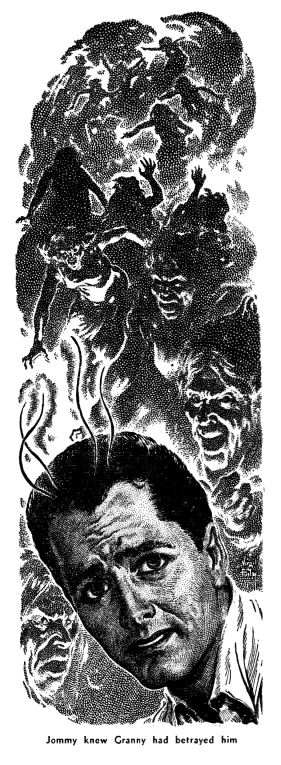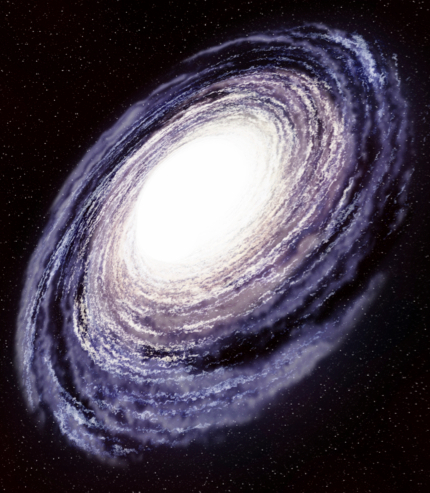Overview
All revisions made to Slan over the years can be categorized as minor, and the overall story is substantially the same regardless of which version you read. However, study of these other versions is still fascinating and rewarding, as van Vogt's continuous development as a writer — even well into his career! — is vividly demonstrated.
No fewer than five different versions of the novel have seen print over the decades. However, although there are distinct differences between each of these five versions, to think of the novel as consisting of five unique versions tends to needlessly overcomplicate things. Roughly speaking, there are only two main versions of the novel: the 1940/46 version, and the 1951/68 version. Within these two main groups, there are minor variations between the 1940 and 1946 versions, and between the 1951 and 1968 versions.
(You'll notice that I've left out one of the five versions from either of these main groups. This "loner" version of Slan, which appeared in the Summer 1952 issue of Fantastic Story, can honestly be described as insignificant, and is not worth studying or discussing. For more on the reasons why this is so, see below.)
The major changes made to the novel can be summed up fairly easily:
- More chapter divisions were added in 1946 (for full details, see below).
- Prior to 1951, most changes made to the novel were stylistic in nature.
- Most of the significant alterations to the story itself were done in 1951 (Chapter 18 heavily altered) and 1968 (Jem Lorry and Davy Dinsmore given expanded roles).
Litmus Test
How can you tell which version of the novel you have? There are a few easy tests you can perform to find out. Unfortunately, as far as I have been able to determine, there is no single passage that differs in every version. So, to be absolutely certain, you're going to have to take a look at a handful of different passages. I've tried to make all of these passages as quick and easy to locate as possible — most are at the beginning of key chapters.
- 1940 — If Chapter 6 starts out with the sentence "Jommy's fifteenth birthday!" (with an exclamation mark instead of a period) then you're reading the original 1940 serial.
- 1946 — If the third paragraph in Chapter 1 contains the sentence "Somebody reported us, and our house has already been raided.", and Chapter 7 starts out with the words "Jommy's fifteenth birthday." (with no exclamation mark), then you're reading the 1946 version of the novel.
- 1951 — If Chapter 7 starts out with the words "The acquisition of money corrupted Granny." and Chapter 8 starts out with "Kathleen Layton clenched her fists into small, firm, brown knobs." then you're reading the 1951 version of the novel.
- 1952 — If Chapter 9 starts out with the sentence "With flashing eyes, Kathleen Layton clenched her fists." then you're reading the 1952 version.
- 1968 — If Chapter 8 starts out with the words "As seventeen-year-old Davy Dinsmore approached her, Kathleen Layton caught the thought that was in his mind." then you're reading the 1968 version.
| List of Different Versions | |||
|---|---|---|---|
| 1940 |  |
(Magazine serial) |
|
| 1946 | 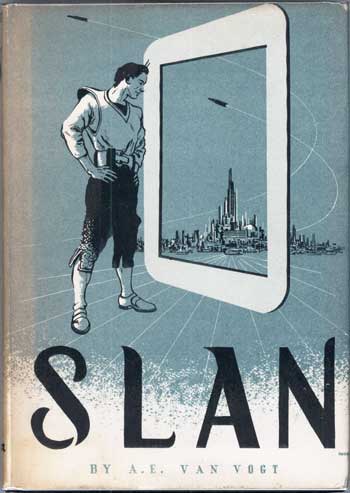 |
(Hardback book, first book publication) |
|
| 1951 |  |
(Hardback book) |
|
| 1952 | 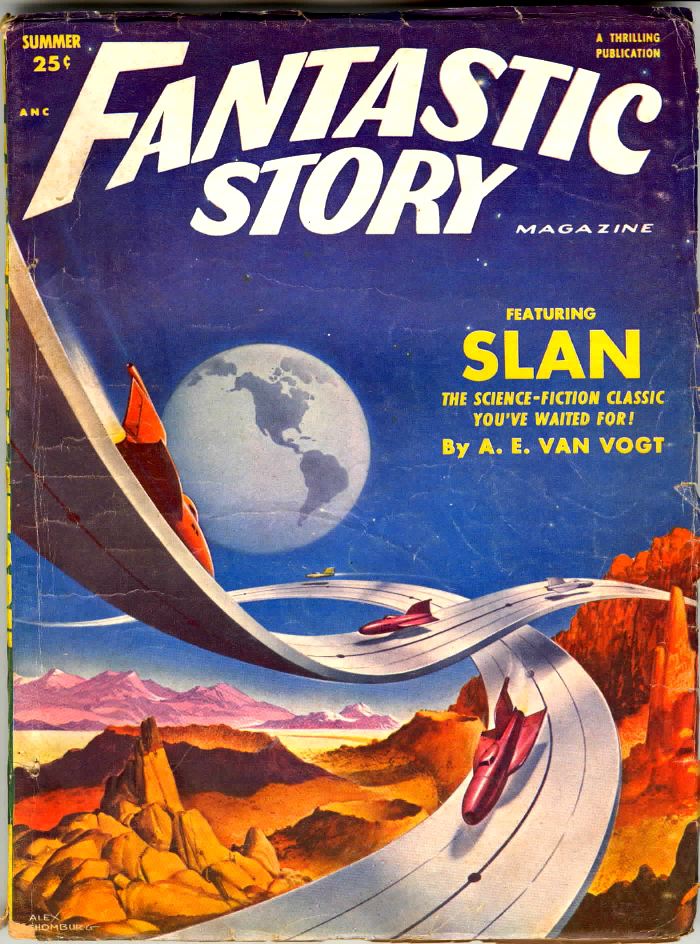 |
(Magazine reprint) |
|
| 1968 | 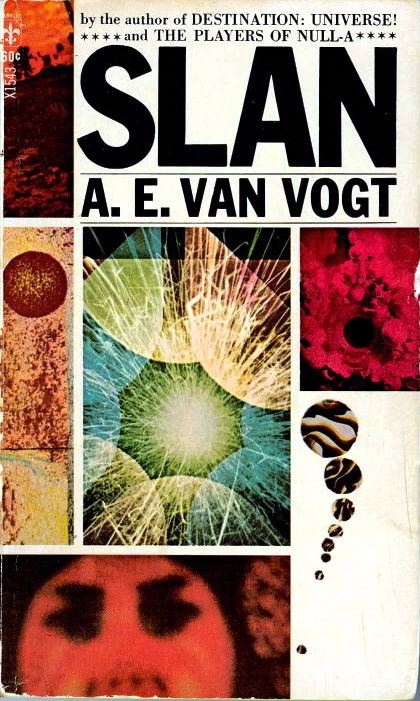 |
(Paperback book) |
|
Chapter Divisions
The chapter divisions for the serial are different than all of the book versions of the novel. This chart shows which chapter divisions correspond with which. Roman numerals are used for the chapter numbers in the serial; arabic numerals are used for the book versions.
The chapters in the 1940 serial were often split in half between installments, so that the first half would appear at the end of one installment and be resumed in the next. This was an unusual procedure. The usual method with serials was that the end of an installment was always also the end of a chapter. In the 1946 book version, all of the installment breaks were later made into a regular chapter breaks.
(The abridged 1952 reprint found in Fantastic Story Magazine is not included here — since a fair amount of material was removed from the novel, its chapter divisions do not correspond to any other version. But since this text is a "blind alley" of sorts, and of limited interest, I've decided to exclude its chapter divisions from the chart.)
| 1940 Serial | 1946 Onward | |||
|---|---|---|---|---|
| Part I | Chapter I | Chapter 1 | ||
| Chapter II | Chapter 2 | |||
| Chapter III | Chapter 3 | |||
| Chapter IV | Chapter 4 | |||
| Chapter V | Chapter 5 | |||
| Part II | Chapter 6 | |||
| Chapter VI | Chapter 7 | |||
| Chapter VII | Chapter 8 | |||
| Chapter VIII | Chapter 9 | |||
| Part III | Chapter IX | Chapter 10 | ||
| Chapter X | Chapter 11 | |||
| Chapter XI | Chapter 12 | |||
| Chapter XII | Chapter 13 | |||
| Chapter XIII | Chapter 14 | |||
| Part IV | Chapter 15 | |||
| Chapter XIV | Chapter 16 | |||
| Chapter XV | Chapter 17 | |||
| Chapter XVI | Chapter 18 | |||
1940 — Astounding Serial
First appearance of Slan.
Serialized in Astounding Science Fiction magazine from September through December 1940.
The original 1940 text had many of the characteristics of Van's early magazine work. It comes across as "first draft" material, written very quickly with very little looking back, streamlining, ironing out inconsistencies, or cutting out unnecessary detail. This was undoubtedly because these were written on a tight deadline, and he did not have the luxury of going back over previously written material as meticulously as he would have liked. The fact that he spent much of his career revising the magazine versions of his novels and stories indicates that he never really considered these serials to be the ideal version, and it was only after becoming an established and financially secure author that he was finally afforded the time to go back and "finish" his novels properly for book publication.
As discussed above, the later chapter divisions in this 1940 version differ from the book versions.
Each part of the serial contained the same full-page illustration for the title page, and two illustrations within the text. All were done by Charles Schneeman.
Style
- The 1940 serial version features an uncharacteristic use of slang. This makes the material feel juvenile and dated. For instance, Jommy calls his father "the big man" in Chapter XXIII of the serial where he's talking to Kathleen (Chapter 14 from 1946 onward). Oddly enough, this was changed to "big shot" in 1946, but was changed to the more mature "great man" in 1951.
- Granny is described in more grotesque terms; reference is made to her "thin scab of a face."
- Phrasing tends to be a little rough and rambling, lacking the polish of the 1951 text. Also, a lot of the extraneous adjectives and adverbs were removed in 1951.
- A profusion of exclamation marks where a simple period would suffice
- Heavy use of commas and semicolons
- Frequent scene breaks (perhaps put in by the editor for layout purposes)
- Paragraphs are shorter in the serial (again, probably done by the editor for layout purposes — short paragraphs look better in narrow magazine columns than long paragraphs do)
Content
- In the first showdown between Gray and Petty, three dictators are named in their conversation: Napoleon, Hitler, and Tharg. Tharg was undoubtedly a figure meant to have ruled between our time and Jommy's. This was changed in 1951 to mention only two dictators, Napoleon and Stalin.
- This and the 1946 text contain a highly amusing anachronism, considering the far-future background of the story. In Chapter I, John Petty's car is described as a "sixty electro Studebaker." Studebaker met its demise in 1967, well before the 36th century. (Indeed, the very idea of any single company lasting through the next Dark Ages stretches credibility.) Although rather fun for its pure bizarro value, this reference was sensibly removed in 1951.
- In Chapter I, the intersection where Jommy alights from Petty's car is 437th Street, described as being "near the outskirts" of the city. In 1951 this was changed to "57th Street" and was close to the city's center.
- Dates are often different in the serial. For example, prior to 1951, seven years rather than three elapsed between Kathleen's death and the tendrilless attack on the ranch, making Jommy's age at the end of the novel 26 rather than 23.
- Although the "minus energy principle" is mentioned in the last chapter of every version, an additional reference to it is included in the serial during the tendrilless attack on the valley. Why this was removed in 1946 is something of a mystery.
- The city of the palace is unnamed in both the 1940 and 1946 text. Only in 1951 was it given the name Centropolis. In the 40's versions, this city is specifically described as being 80 miles across in size and having 30 million inhabitants. This description was removed for some reason in 1951.
- One of the more interesting scenes removed in 1951 was where Jommy sees for himself a room full of "failed" mutant infants in Cimmerium while waiting to be shown in to Mrs. Corliss at the hospital.
- While waiting to see Joanna, Jommy consults the Statistics Machines on his own and learns of Lann's diaries. In 1951, Joanna showed him these records at the end of the chapter.
- Originally, Lann's diaries begin in the year 1971; in the Simon & Schuster edition this was changed to a hundred years later, 2071. Also, these journal entries in the 1940s versions of the novel are more subjective and show signs of paranoia on Lann's part. In 1951 they were rewritten to be more objective and rational.
- In the 1940s versions of the novel, the date of Jommy's arrival at the palace grounds at the end of the novel is given as "May." In 1951 this was changed to "late spring."
Chapter 18
The final chapter of the novel is markedly different in the 1940s versions, and was revised considerably in 1951. The original version, I feel, is stronger and more lucid, and I think it's a shame that he changed it. The differences are too many to enumerate individually, but here are the major differences:
- When Jommy has just entered the tunnel, there is a rather obscure but highly atmospheric sentence that was removed in 1951: "There were doors and corridors, and great stately rooms, like long abandoned funeral homes, like the temple of the dead-lost Chiir-folk that stood through all eternity in the shadows of Mount Gog in the upper Saemones Valley." (If the Saemones Valley is an actual place, I have been unable to find any reference to it. In all likelihood, this is a fictitious location.)
- The signs throughout the underground tunnel make it clear that these passages come under the jurisdiction of the slans, not the humans, and that slan law forbids unauthorized entry. From 1951 onward, the reader merely gets the impression that these signs warn of the danger to slans from humans within the palace.
- It's also made clear that these warnings are current, not dating from the slans' control of the palace, as they mention Kier Gray by name. Even more startling, when Gray meets Jommy he tells him that the penalty for unauthorized use of these passageways is to have the tendrils removed by order of the slan council within the palace, supposedly done for the slan's own protection.
- Gray makes the rather ludicrous assertion that only his (non-slan) cleaning lady is allowed into his most private and closely guarded inner chambers! In 1951, it's made clear that no one at all is allowed there but Gray and his slan associates.
- Samuel Lann's wife really was the mother of the first slan children in the 1940s versions, though no "mutation machine" was used on her. In 1951, this was changed so that the mother of the first slans was not Lann's wife. This was perhaps changed because van Vogt deemed it too unlikely that the only perfect mutations ever born would be born to a scientist of all people.
- More explicit emphasis is placed on the idea of humanity functioning as a single interconnected organism with many parts, to explain the sudden universal outburst of mutations. This is one of the many sections in the final chapter which were, for whatever reason, muddied and made more vague in 1951.
- It is clearly stated that the tendrilless slans are the true slans, but camouflaged or in a dormant state of sorts. Jommy asks Gray "Are you trying to tell me that the tendrilless slans are the true slans?" A slight but significant change was made in 1951; Jommy instead asks if the tendrilless "will eventually be" the true slans.
-
In the 1940s versions, Gray offers solutions to both the problem with humanity and the tendrilless attack. Again, this was revised in 1951 to be more vague and open-ended. Mark McSherry has suggested that this may indicate that van Vogt was intentionally making things less certain, to pry the door open to allow for a sequel.
The original passage reads as follows:
"Your hypnotism crystals, of course, are the final solution to the human being problem. Not one of us but can have pity for their position. Thank Heaven, in less than a hundred years, long before the situation becomes acute, there'll be enough tendrilled slans to hypnotize every human being; and so their passing will be painless and happy.
"As for the imminent attack, we have spaceships. We shall fit them with your atomic drivers and projectors, and make a big noise with a small force. My colleagues have a few tricks of their own that they've been saving for this moment; and the combination, plus a speech by you on the tendrilless slan radio, should provide us with that fifty-year delay.
"You can tell them that ever since their attack on your valley, human factories have been turning out weapons, but that you have given away no secrets . . . that should make them feel basically safe."
1946 — Arkham Hardback
First book publication.
A minor revision to the 1940 serial.
This was very similar to the contents of the 1940 serial. Some of the rougher aspects of the "first draft" feel of the serial were done away with, with most of the changes being stylistic rather than story content. These stylistic changes were carried over into the 1951 version (which also added many further changes).
The text of the Arkham edition was reprinted once, as a hardback by the Science Fiction Book Club in 1978. Since the Arkham version is so similar to the original Astounding version, buying this book club edition is an affordable alternative to the more expensive issues of Astounding (to say nothing of the rare Arkham edition!).
Major Differences
- Frequent rewording of phrases
- Extraneous and redundant details cut out
- Excessive verbiage trimmed
- Most (but not all) of the slang usage was removed, using more cultivated and less "juvenile" words instead
- Since this edition was released the year after the end of World War II, van Vogt added a few references to atomic bombs (on pages 78, 154, & 167 of the Arkham edition). Some of these descriptions were further refined in 1951 when more was known to the general public about atomic weapons.
1951 — Simon & Schuster Hardback
Second book publication.
Substantial revisions to the 1946 text.
This edition marks the first time that Slan was available from a major publisher, and was something of a major event in the SF community at the time, even warranting a full-page ad in the January 1952 issue of Astounding. Prior to that, fans had had to pay outrages sums of money for the ultra-rare Arkham edition.
Style
- Most of the stylistic changes made in 1946 were carried over to this edition, though sometimes with slight alterations. Many additional stylistic changes were also made, making this the smoothest and most streamlined version of the text up to that point.
- Many details were changed from the 1940 and 1946 versions. For example, the infamous Studebaker reference was removed from Chapter One.
- New details were added, enriching or clarifying the story's background.
- Many descriptions are fuller and clearer.
Content
- The apartments in the derelict section of town are now described as having been built out of plastic 100 years previously (10). All others references to plastic in the novel were likewise new to this edition.
- Jommy's self-education at the beginning of Chapter 7 is described in much greater detail than in previous versions.
- More details about the valley ranch have been added to Chapter 12.
- In Chapter 14, it is now made clear to Jommy that it is a slan girl the authorities are searching for. In previous versions, Jommy only knew that it was a girl.
Chapter 18
As noted above, Chapter 18 underwent radical changes in the 1951 version. The ten paragraphs following "He reached toward a buzzer button on his desk, and pressed it." near the end of Chapter 18 are new to this edition, and were carried over into the 1968 version. Information presented in this new section include:
- Details on how the passages into the palace were made secret, and how they remained secret
- A smattering of information about the slans living in the palace
- Kathleen's life and death, as well as some references to Gray's late wife, are discussed
- It's made clear that tendrilled slans are kept in the palace mainly as a means of showing the tendrilless slans what their descendants will be like
- A paragraph is added near the very end, giving a brief but vivid description of the telepathic exchange of information between Jommy and three of Gray's slan associates
1952 — Fantastic Story
Magazine reprint.
An abridged and slightly-rewritten version of the 1940 serial.
The Summer 1952 issue of Fantastic Story magazine featured an abridged version of the 1940 serial. (As such, from a technical standpoint, it should be grouped together with the 1940/46 version.)
Minor scenes are eliminated, and numerous descriptions are tightened up by discarding the occasional word or phrase. There are some sentences that have been altered or newly added by the editor to better bridge the gaps where material has been removed. Bizarrely, there are also numerous other arbitrary changes throughout the text that seem to be nothing more than minor tweaks with the writing style. And to further muddy the waters, the chapter divisions here are different than any other version. All of these factors make comparison with the other versions of Slan an incredibly tedious and difficult task.
This abridgement only appeared once, in this issue of the magazine, and never again. When we consider that this magazine must have seen relatively limited circulation, and that the original serial of Slan had already been superceded by no fewer than two different book editions of the novel, and that this version of the serial has been distorted almost beyond recognition anyway, I believe this version can honestly be described as an insignificant curiosity and not worth studying or discussing.
This abridgement was undoubtedly the work of Samuel Mines, the editor of the magazine at the time. As far as I know van Vogt had no creative input into this version; it was just a routine reprint of a classic SF story, in a magazine whose primary purpose was to provide cheap pulp reprints of SF classics.
The only noteworthy thing about this version is some nice illustrations by Virgil Finlay:
1968 — Berkley Paperback
Paperback, new edition.
Further revisions to 1951 version.
Apart from some specific scenes, this is essentially the 1951 version of the novel. Its main difference is some further, very specific revisions to two of the minor characters. Van Vogt may have decided to make these alterations as late as 1968 because of his study of Dianetics that took up much of his time from 1950 to 1970. His deeper interest in people and their motivations may have inspired him to work on his characterization techniques.
Characterization
Two minor characters, Davy Dinsmore and Jem Lorry, are given substantial overhauls. While they remain minor players in the story, they are given fuller back stories and more interesting roles.
- Davy was a straight villain in previous versions, who tormented Kathleen when they were children and pursued her as a young adult for her physical attractiveness. In 1968, he is turned into Kathleen's friend, pupil, then suitor as they grow up together. He still taunts her in Chapter 2, but his motivation for doing so is to warn her that her life is in danger since she will not read his mind and has been himself warned that openly being her friend during this time could endanger his own life. Also, in previous versions he taunts her alone, whereas in 1968 he has a gang of friends with him. All of his appearances after that are basically ground-up rewrites of his original scenes.
- Jem Lorry is given more of a background than he was given in the original, and the conversation between him and Kathleen in Chapter 8 is more intelligent and in-depth. It's also shown how he manipulated his many mistresses for his own political agenda.
Terraforming Mars
A lengthy footnote about the terraforming of Mars using ice asteroids was added to Chapter 16 (page 153). When the novel first appeared in 1940 it was thought that Mars and Venus had naturally breathable atmospheres. During the early 1960s more was learned about these two planets during the Cold War Space Race, and van Vogt inserted this new information to bring the story more in line with the latest discoveries about the actual nature of Mars.
Interestingly, just two years later when van Vogt revised The World of Null-A, the same technique was used in the story to terraform Venus. Reading these sections from the two novels, one after the other, gives one a strange feeling of déjà vu!
The same legend that had portrayed man or slan as once having spaceships whispered the myth that huge ice or oxygen meteorites from Jupiter and Saturn — comprising thousands of cubic miles of frozen water and frozen air — had been guided toward all the potentially habitable planets, and exploded. This immense debris, falling onto the barren worlds of Mars, Venus, and some of the moons of Jupiter, created — it was said — oceans and vast atmospheres where none, or at least nothing worthwhile, had been before.
—Slan (1968), Chapter 16 (Berkley edition page 153)
[Gosseyn] picked up the volume on Venusian history. It told the story of the first men to walk on Venus late in the twentieth century. It described how the boiling hell of that atmosphere was tamed as early as the first quarter of the twenty-first century, of how ice meteorites from Jupiter were coasted into a close orbit around Venus, and of how as a result it rained for thousands of days and nights.
The ice meteorites ranged in size from ten to a hundred cubic miles; and when they had melted their huge volume of water down on the surface, and into the atmosphere, Venus had oceans and oxygen in its atmosphere.
—The World of Null-A (1970 version), Chapter 10 (Berkley edition page 73)
